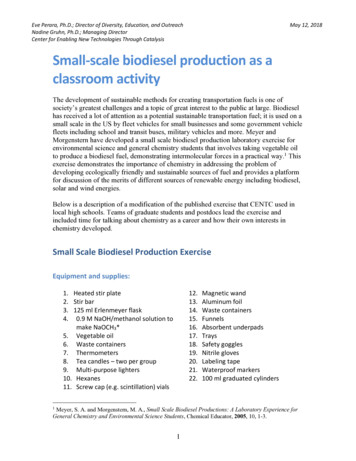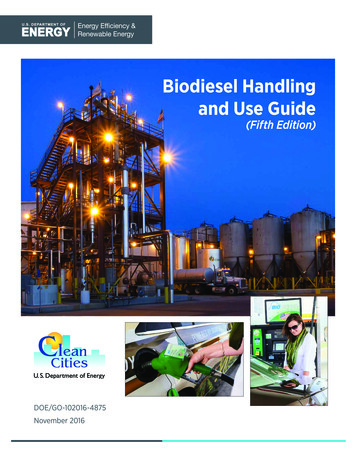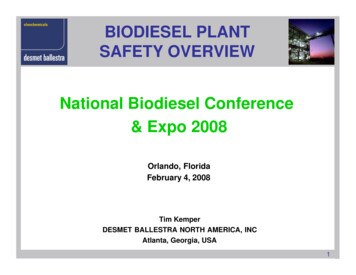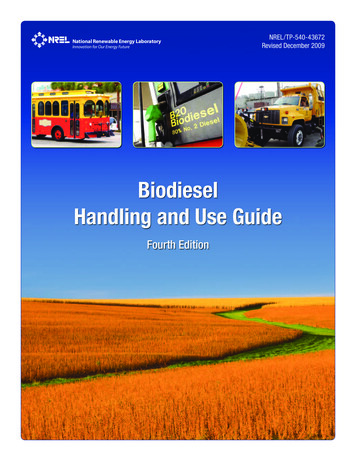
Transcription
Eve Perara, Ph.D.; Director of Diversity, Education, and OutreachNadine Gruhn, Ph.D.; Managing DirectorCenter for Enabling New Technologies Through CatalysisMay 12, 2018Small-scale biodiesel production as aclassroom activityThe development of sustainable methods for creating transportation fuels is one ofsociety’s greatest challenges and a topic of great interest to the public at large. Biodieselhas received a lot of attention as a potential sustainable transportation fuel; it is used on asmall scale in the US by fleet vehicles for small businesses and some government vehiclefleets including school and transit buses, military vehicles and more. Meyer andMorgenstern have developed a small scale biodiesel production laboratory exercise forenvironmental science and general chemistry students that involves taking vegetable oilto produce a biodiesel fuel, demonstrating intermolecular forces in a practical way.1 Thisexercise demonstrates the importance of chemistry in addressing the problem ofdeveloping ecologically friendly and sustainable sources of fuel and provides a platformfor discussion of the merits of different sources of renewable energy including biodiesel,solar and wind energies.Below is a description of a modification of the published exercise that CENTC used inlocal high schools. Teams of graduate students and postdocs lead the exercise andincluded time for talking about chemistry as a career and how their own interests inchemistry developed.Small Scale Biodiesel Production ExerciseEquipment and supplies:1. Heated stir plate2. Stir bar3. 125 ml Erlenmeyer flask4. 0.9 M NaOH/methanol solution tomake NaOCH3*5. Vegetable oil6. Waste containers7. Thermometers8. Tea candles – two per group9. Multi-purpose lighters10. Hexanes11. Screw cap (e.g. scintillation) vials12.13.14.15.16.17.18.19.20.21.22.1Magnetic wandAluminum foilWaste containersFunnelsAbsorbent underpadsTraysSafety gogglesNitrile glovesLabeling tapeWaterproof markers100 ml graduated cylindersMeyer, S. A. and Morgenstern, M. A., Small Scale Biodiesel Productions: A Laboratory Experience forGeneral Chemistry and Environmental Science Students, Chemical Educator, 2005, 10, 1-3.1
Eve Perara, Ph.D.; Director of Diversity, Education, and OutreachNadine Gruhn, Ph.D.; Managing DirectorCenter for Enabling New Technologies Through CatalysisMay 12, 2018* For 10 groups, measure 150 ml of methanol into 500 ml Erlenmeyer flask (before handlingmethanol read safety data sheet (MSDS) .Weigh out 5 g sodium hydroxide (see MSDS www.labchem.com/tools/msds/msds/LC24350.pdf)Crush pellets into powder with mortar and pestle, transfer into methanol and stir on magnetic stirplate for 5-10 min. until dissolved.Procedure:Use safety goggles at every step of the procedure. Gloves are also useful whenhandling materials.1. Pour 14 ml of 0.9 M NaOH/methanol solution into 125 ml Erlenmeyer flask. Thesodium hydroxide reacts with the methanol to form sodium methoxide (NaOCH3)by this reaction:NaOH CH3OH NaOCH3 H2O2. Add 60 ml of vegetable oil to flask. Add stir bar and, using a heated stir plate onlow setting, slowly heat the solution to a temperature between 35 C and 50 Cwith constant stirring, about 20 – 30 minutes. Check thermometer frequentlytaking care not to break it with the stir bar.3. Let mixture cool and separate into two distinct layers. The clear, yellow top layeris the biodiesel product. The cloudy, colorless bottom layer contains glycerol,methanol and salts. The bottom layer may be a slightly solid plug. This is OK.Carefully pour the top layer into a graduated cylinder trying not to disturb thebottom layer. Record the volume of your biodiesel product and calculate thepercent of biodiesel conversion based on the volume of oil you began with. Thegenerally accepted conversion rate is about 70%.4. Remove candles from two tea candle tins andadd a small amount of biodiesel into one andstarting oil into the other. Swirl gently andnotice any differences in viscosity. Replacewicks and fill the tins containing wicks – onewith the starting oil and the other with theresulting biodiesel fuel. Use a lighter to lightthe wicks. Observe how each oil burns. Thebiodiesel should burn more vigorously than thestarting oil. Pour glycerol and biodiesel into waste containers.2
Eve Perara, Ph.D.; Director of Diversity, Education, and OutreachNadine Gruhn, Ph.D.; Managing DirectorCenter for Enabling New Technologies Through CatalysisMay 12, 2018Teaching pointsCatalysis – use of chemicals that accelerates rate of reaction while not being consumed inthe reaction. In this case the catalyst is methoxide in the form of sodium methoxide. Inlarger scale biodiesel production, the catalyst can be separated from the products andreused in another reaction.Glycerol waste - Referring to the chemical reaction, one can see that for every moleculeof fuel generated, a molecule of glycerin is also generated. Glycerin is considered a coproduct of biodiesel production and in order for biodiesel to be used on a wide scale,scientists must develop a way to use glycerin to manufacture products that are useful on ascale similar to biodiesel fuel. Glycerin can be used for making soap, but the demand forthe soap is much lower than that for the fuel. Scientists are currently working on ways touse the glycerin for development of other useful chemicals.1 triglyceridecatalyst/alcohol1 glycerol3 estersNaOH/CH OH3 Heat at 50 ºCBiodieselGlycerolVegetable OilIntermolecular forces – Intermolecular forces explain the different viscosities of thestarting vegetable oil, the biodiesel product and the glycerol. Biodiesel is less viscousthan the starting oil because the smaller esters are more mobile than the largertriglycerides that comprise vegetable oil. Hydrogen bonding of glycerol molecules makesit very viscous. Glycerol and biodiesel end-products separate into two phases due to theirdifferent polarities. Biodiesel is a better fuel than vegetable oil because it is comprised of3
Eve Perara, Ph.D.; Director of Diversity, Education, and OutreachNadine Gruhn, Ph.D.; Managing DirectorCenter for Enabling New Technologies Through CatalysisMay 12, 2018smaller molecules, thus has a lower melting point and is more volatile than vegetable oil,so it burns more readily.Logistical issues of using biodiesel and comparison with other energy sources – Therealities of relying exclusively on biofuels for current and projected energy needs – Landuse: competing needs of providing food vs. fuel, do we have capacity to provide thenecessary amount of biofuel. Alternative sources for biodiesel production: wasteproduced from food production or forestry.**** Teaching resources for ideas about chemistry, are available on ACS ef/en.htmlLessons learned For university-based researchers looking for school partners, it may be difficult toget responses from schools that are “cold-called.” Using preexisting relationshipswith local schools through faculty, students or staff can be fruitful.Teachers appreciated that the lesson is self-contained and that volunteers take careof everything so the only prep for them is preparing students forlesson/experience.Most appropriate for general chemistry or physical sciences students – usuallyfreshmen.Requires many volunteers and quite a bit of coordination. Volunteers wererecruited from grad students and postdocs from department. Some preparation isprovided.Needs some equipment probably not available at schools: Erlenmeyer flasks (125ml) and heated stir plates. Do NOT use open flames such as Bunsen burners dueto the volatility of the biodiesel. We paired students up so one each for every pair.We bought flasks for the exercise, but were able to check out the stir plates fromthe undergraduate lab stockroom.The oil can be difficult to clean. Be sure to use plastic boxes lined with absorbentpads for storing and transporting the oil. Use trays with absorbent pads on thebenches.4
Eve Perara, Ph.D.; Director of Diversity, Education, and OutreachNadine Gruhn, Ph.D.; Managing DirectorCenter for Enabling New Technologies Through Catalysis5May 12, 2018
product of biodiesel production and in order for biodiesel to be used on a wide scale, scientists must develop a way to use glycerin to manufacture products that are useful on a scale similar to biodiesel fuel. Glycerin can be used for making soap, but the demand for the










